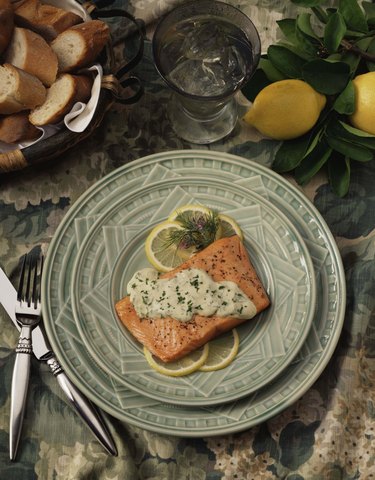
Unless you have the good fortune to live in a coastal area, high-quality frozen fish is often better than the never-frozen fillets at your local grocer. Salmon is often blast-frozen right on the boat, if caught wild, or at the production facility if it's raised on a farm, just moments after it's processed. Those frozen portions are best thawed before cooking, but if you're pressed for time, you can steam them right from the freezer.
The Virtues of Salmon
Video of the Day
Salmon trails only shrimp and canned tuna among the most popular seafood in the United States. A number of reasons contribute to its popularity. It has a flavor mild enough to appeal to most diners, but it's rich enough to stand up to a wide range of preparations. Salmon portions are harder to overcook than many other popular options because of their thickness and relatively high levels of fat. Even salmon's fat is a positive since it's an outstanding source of heart-healthy omega-3 fatty acids. Finally, the plentiful supply of wild-caught Pacific salmon and farmed Atlantic salmon means that prices for good salmon are relatively low.
Video of the Day
Steaming Your Salmon
You can cook your salmon using the most common cooking methods: grilling, broiling, steaming and poaching. Steaming is an excellent choice for health-conscious diners since it adds no extra calories during the cooking process. Countertop electric food steamers are the easiest to use, with timers and convenient stacking baskets for food. If you don't have an electric steamer, you can steam salmon in a steamer basket in a pot with a tight-fitting lid. Even a small wire rack in the bottom of a pot will serve the purpose. For the steaming liquid, you can use water, wine, beer, cider or broth, and you can add herbs, spices or even seaweed for flavor.
Steaming From Frozen
Typically, thin salmon portions can be steamed and ready to serve in 5 to 6 minutes, while slices from the thickest portion of the fillet may need 8 to 12 minutes to reach the recommended internal temperature of 145 degrees Fahrenheit. Increase the cooking time by half for portions that are 1/2-inch to 3/4-inch thick if you're cooking from frozen. Portions in the 1- to 1 1/2-inch range need more time because of the additional thickness; they may need up to 20 minutes to fully cook in the thickest part of the cut. The steamer will take a minute or two to resume steaming after you add the fish, so don't start timing until it begins to steam again.
Tips
A high risk exists of overcooking the thinner portion of the fillet. To minimize that risk, turn off your steamer or the burner under your pot after the normal cooking time for thawed salmon. Let the salmon rest in the steamer for the remainder of the adjusted cooking time, which cooks the salmon more gently than the fierce heat of active steaming. If you have a digital thermometer with a remote probe, use it to judge when the salmon is done. Otherwise, remove one piece and break it open with a fork at the end of the cooking time. If the salmon is visibly cooked through, with just a hint of darker pink in the middle, it's ready to serve.